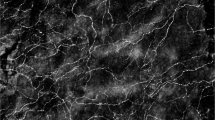Summary
Electrophysiological studies of single visceral afferent fibres are reviewed. Recordings were made from the vagus and pelvic nerves supplying the abdominal and pelvic viscera. Slowly-adapting mechanoreceptors, with non-myelinated afferent axons, end in the muscle coats of the hollow viscera. The receptors are excited by both passive distension and active contraction of the viscera. The strength and duration of visceral contractions, especially the bladder, can be accounted for by the “in series” arrangement of these mechanoreceptors. Rapidly-adapting visceral mechanoreceptors include the Pacinian corpuscle, with no known function, and the recently described “flow” receptor in the urethral mucosa.
Visceral chemoreceptors are less well studied. Slowly-adapting pH sensitive receptors that exist in the gastric mucosa are described and their role in the regulation of gastric activity and in gastric sensations are discussed.
Drug actions on visceral receptors are briefly discussed.
Zusammenfassung
Die Ergebnisse elektrophysiologischer Untersuchungen über die Aktivität einzelner visceraler afferenter Fasern werden zusammengefaßt. Es wurde namentlich die Aktivität des aus abdominalen und pelvischen Organen entstammenden N. vagus und des N. pelvicus registriert. Langsam-adaptierende Mechanorezeptoren mit nichtmyelinisierten afferenten Axonen entstehen aus den Muskelwänden der hohlen Visceralorganen. Diese Rezeptoren werden durch passive Dehnung und aktive Kontraktion der Viscera erregt. Die Stärke und Dauer der visceralen Kontraktionen, speziell bei der Blase, kann der Serienschaltung dieser Mechanorezeptoren zugeschrieben werden. Schnell-adaptierende viscerale Mechanorezeptoren schließen die Pacini-Körperchen mit ein, mit noch unbekannter Funktion, ebenso die kürzlich beschriebenen „Flow”-Rezeptoren in der urethralen Schleimhaut.
Die visceralen Chemorezeptoren wurden weniger untersucht. Langsam adaptierende pH empfindliche Rezeptoren, in der Magenschleimhaut, wurden beschrieben; ihre Rolle bei der Regulierung der gastrischen Aktivität und der Vermittlung der gastrischen Wahrnehmungen wird diskutiert.
Die Wirkung von Medikamenten auf viscerale Rezeptoren wird ebenso kurz behandelt.
Résumé
Les travaux sur l'analyse électrophysiologique de l'activité de la fibre viscérale afférente sont passés en revue. L'activité des nerfs vague et pelvien provenant des viscères abdominales et pelviennes a été enregistrée. Des mécanorécepteurs à adaptation lente, à axones afférents amyéliniques ont été trouvés dans les parois musculaires des viscères creuses. Ces récepteurs sont excités par la distension passive aussi bien que par la contraction active des viscères. L'intensité et la durée des contractions viscérales, en particulier de la vessie, sont dues à l'arrangement ≪en série≫ de ces mécanorécepteurs. Parmi les mécanorécepteurs viscéraux à adaptation rapide, on trouve le corpuscule de Pacini, qui n'a pas de fonction connue, et le ≪flow≫ receptor récemment décrit dans la muqueuse uréthrale.
Les chémorécepteurs viscéraux ont été moins bien étudiés. Des récepteurs sensibles aux variations de pH et doués d'un pouvoir d'adaptation lente, existent dans la muqueuse gastrique; on discute de leur rôle dans la régulation de l'activité gastrique et la transmission des sensations gastriques.
L'auteur passe en revue brièvement l'action de certains médicaments sur les récepteurs viscéraux.
Similar content being viewed by others
References
Adrian, E. D., J. Physiol.79 (1933), 332.
Agostoni, E., J. E. Chinnock, M. de B. Daly, andJ. G. Murray, J. Physiol.135 (1957), 182.
Bülbring, E., R. C. Y. Lin, andG. Schofield, Quart. J. Exper. Physiol., London,43 (1958), 26.
Code, C. F., andG. Watkinson, J. Physiol.,130 (1955), 233.
Daly, M. de B., andM. H. Evans, J. Physiol.120 (1953), 579.
Douglas, W. W., andJ. M. Ritchie, J. Physiol.134 (1956), 167.
Douglas, W. W., andJ. M. Ritchie, Physiol. Rev., Baltimore,42 (1962), 297.
Downman, C. B. B., B. A. McSwiney, andC. C. N. Vass, J. Physiol.107 (1948), 97.
Evans, J. P., J. Physiol.86 (1936), 396.
Fjällbrant, N., andA. Iggo, J. Physiol.156 (1961), 578.
Gasser, H. S., J. Gen. Physiol.38 (1955), 709.
Gernandt, B., andY. Zotterman, Acta physiol. Scand.12 (1946), 56.
Gray, J. A. B., andJ. L. Malcolm, Proc. Roy. Soc., London, Biol. Sc.,137 (1950), 96.
Guzman, F., C. Braun, andR. K. S. Lim, Arch. internat. Pharmacodyn.136 (1962), 353.
Heymans, C., andE. Neil, Reflexogenic Areas of the Cardiovascular System. Churchill, London, 1958.
Hurst, A. F., The Sensibility of the Alimentary Canal. Oxford University Press, London, 1911.
Iggo, A., J. Physiol.128 (1955), 593.
Iggo, A., XXth Int. physiol. Congr. (1956), 458.
Iggo, A., Quart. J. Exper. Physiol., London,42 (1957a, b), 130 and 398.
Iggo, A., J. Physiol.142 (1958), 110.
Iggo, A., in Studies in Physiology.Ed. Curtis, D. R., andA. K. McIntyre, Springer-Verlag, Berlin, 1965.
Langley, J. N., andH. K. Anderson, J. Physiol.19 (1896), 372.
Lennander, K. G., Zbl. Chir.28 (1901), 209.
Lennander, K. G., Mitt. Grenzgeb. Med. Chir., Jena,15 (1906), 465.
Loewenstein, W. R., Ann. N. Y. Acad. Sc.94 (1961), 510.
Mellanby, J., andC. L. G. Pratt, Proc. Roy., Soc., London, Biol. Sc.,127 (1939), 307.
Niijima, A., Jap. J. Physiol.12 (1964), 25.
Paintal, A. S., J. Physiol.126 (1954a, b), 255 and 271.
Paintal, A. S., J. Physiol.139 (1957), 353.
Paintal, A. S., Erg. Physiol.52 (1963), 74.
Payne, W. W., andE. P. Poulton, J. Physiol.63 (1927), 217.
Ranson, S. W., Physiol. Rev., Baltimore,1 (1921), 477.
Sherrington, C. S., The Integrative Action of the Nervous System. New York, Scribners 1906.
Sircus, W., Quart. J. Exper. Physiol., London,43 (1958), 114.
Talaat, M., J. Physiol.89 (1937), 1.
Titchen, D. A., J. Physiol.141 (1958), 1.
Todd, J. K., Quart. J. Exper. Physiol., London,49 (1964), 258.
Tower, S. S., J. Physiol.78 (1933), 225.
Von Euler, U. S., G. Liljestrand, andY. Zotterman, Skand. Arch. Physiol.83 (1939), 132.
Whitteridge, D., in Lectures on the Scientific Basis of Medicine4 (1954) 305. Athlone Press, London.
Zotterman, Y., Olfaction and Taste, Pergamon Press, London, 1963.
Author information
Authors and Affiliations
Additional information
With 7 Figures
Rights and permissions
About this article
Cite this article
Iggo, A. Physiology of visceral afferent systems. Acta Neurovegetativa 28, 121–134 (1966). https://doi.org/10.1007/BF01227376
Issue Date:
DOI: https://doi.org/10.1007/BF01227376




